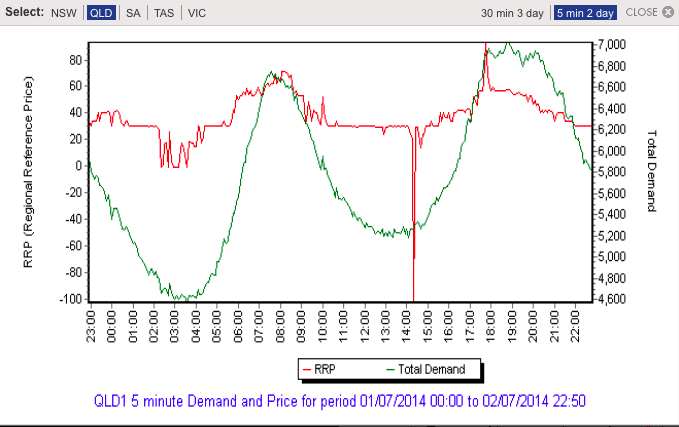European Power Prices Plunge: Solar Surge Sends Prices Below Zero

Table of Contents
The Surge in Solar Power Production
The recent significant increase in solar energy generation across Europe is the primary driver behind the plummeting power prices. Several factors contribute to this remarkable growth in solar power generation:
- Record-breaking solar power output in several European countries: Countries like Germany, Spain, and Italy have reported record-high solar energy production during peak sunlight hours, significantly exceeding initial projections. This is a testament to the growing capacity of solar energy infrastructure across the continent.
- Expansion of solar farms and rooftop solar installations: The widespread adoption of solar panels, both on a large scale (solar farms) and a smaller scale (rooftop installations), has significantly increased the overall solar energy capacity within the European electricity grid. Government incentives and decreasing installation costs have fueled this growth.
- Impact of improved solar panel technology and efficiency: Advances in photovoltaic (PV) technology have led to more efficient solar panels, capable of generating more electricity from the same amount of sunlight. This improvement in efficiency plays a crucial role in the overall increase in solar power generation.
- Role of government subsidies and renewable energy targets: Many European governments have implemented substantial subsidies and set ambitious renewable energy targets, incentivizing the development and deployment of solar power infrastructure. This policy support has been instrumental in driving the expansion of solar energy capacity.
Negative Electricity Prices: Understanding the Mechanics
The surplus of solar energy, particularly during peak sunlight hours, is the key to understanding negative electricity prices. When solar power generation significantly exceeds demand, the price of electricity can fall below zero. This seemingly paradoxical situation arises from the mechanics of the electricity market:
- Explanation of how supply exceeding demand drives prices negative: In a competitive electricity market, prices are determined by supply and demand. When supply (solar energy) massively exceeds demand, producers are essentially paying consumers to take the excess electricity off their hands, resulting in negative prices.
- Challenges of grid integration for large-scale renewable energy: Integrating large amounts of intermittent renewable energy, like solar power, into the electricity grid presents significant challenges. The grid needs to be able to handle the fluctuations in supply, which can be difficult to manage with such a variable energy source.
- Role of energy storage technologies (batteries, pumped hydro) in mitigating negative pricing: Energy storage technologies, such as large-scale battery systems and pumped hydro storage, play a critical role in mitigating negative pricing by storing excess solar energy for later use when demand is higher. However, current storage capacity is not sufficient to completely absorb the surplus during peak solar production.
- Implications for electricity producers and consumers: Negative electricity prices negatively impact conventional power plants, forcing them to curtail production or operate at a loss. Conversely, consumers can benefit from this excess, although the benefits are rarely directly passed on to end-users due to market structures.
Implications for the European Energy Market
The trend of negative electricity prices, driven by the surge in solar energy, has profound implications for the future of the European energy market:
- Accelerated shift towards renewable energy sources in Europe: The demonstrated success of solar energy in driving down prices reinforces the momentum towards a renewable energy-based future.
- Need for investments in smart grids and energy storage solutions: To efficiently manage the fluctuating output of renewable energy sources, significant investments in modernizing electricity grids and expanding energy storage capacity are necessary.
- Impact on the profitability of conventional power plants: Traditional power plants reliant on fossil fuels and nuclear energy face decreased profitability and even potential closure in the face of abundant, cheaper solar power.
- Opportunities for new business models in the energy sector: The shift toward renewable energy creates opportunities for new business models, particularly in areas like energy storage, grid management, and demand-side management.
- Potential for reduced carbon emissions and improved air quality: The increased reliance on solar power contributes significantly to the reduction of carbon emissions and the improvement of air quality, aligning with the broader goals of climate change mitigation.
Challenges and Opportunities
While the surge in solar energy production offers numerous benefits, it also presents challenges:
- Grid modernization: Existing grid infrastructure may not be adequately equipped to handle the intermittent nature of solar power, potentially leading to instability and outages. Upgrades and smart grid technologies are crucial.
- Energy storage technologies: The lack of widespread, cost-effective energy storage remains a constraint. Further investment in battery storage, pumped hydro, and other technologies is needed to effectively manage fluctuations in solar power generation.
- Policy support: Consistent and supportive government policies are crucial to ensure continued investment in solar energy and the necessary grid infrastructure. Effective regulatory frameworks are needed to address the challenges and opportunities presented by this transition.
- Renewable energy integration challenges: Integrating large-scale renewable energy sources requires careful planning and coordination to ensure grid stability and reliability. Advanced forecasting techniques and grid management strategies are essential.
- Energy market regulation: Market regulations must adapt to the changing dynamics of the electricity market to ensure fair competition and efficient resource allocation.
Conclusion
The plunge in European power prices, driven by a surge in solar energy, marks a significant milestone in the energy transition. While challenges remain in effectively integrating such intermittent renewable energy sources, the trend underscores the growing potential of solar power and its role in shaping a cleaner, more sustainable energy future. Understanding the dynamics of this phenomenon is crucial for policymakers and industry players alike. To stay informed about the latest developments in the European energy market and the impact of the solar energy surge on power prices, continue following our updates.

Featured Posts
-
 Metro Vancouver Housing Market Slower Rent Growth Persistent High Costs
Apr 29, 2025
Metro Vancouver Housing Market Slower Rent Growth Persistent High Costs
Apr 29, 2025 -
 Black Hawk Pilot Rebecca Lobachs Collision Ignoring Co Pilot Warnings
Apr 29, 2025
Black Hawk Pilot Rebecca Lobachs Collision Ignoring Co Pilot Warnings
Apr 29, 2025 -
 Europes Response To Shifting Russian Military Dynamics
Apr 29, 2025
Europes Response To Shifting Russian Military Dynamics
Apr 29, 2025 -
 Update On Louisville Mail Delays Union Leaders Statement
Apr 29, 2025
Update On Louisville Mail Delays Union Leaders Statement
Apr 29, 2025 -
 Minnesota Faces Attorney General Pressure Compliance With Trumps Transgender Sports Ban
Apr 29, 2025
Minnesota Faces Attorney General Pressure Compliance With Trumps Transgender Sports Ban
Apr 29, 2025
